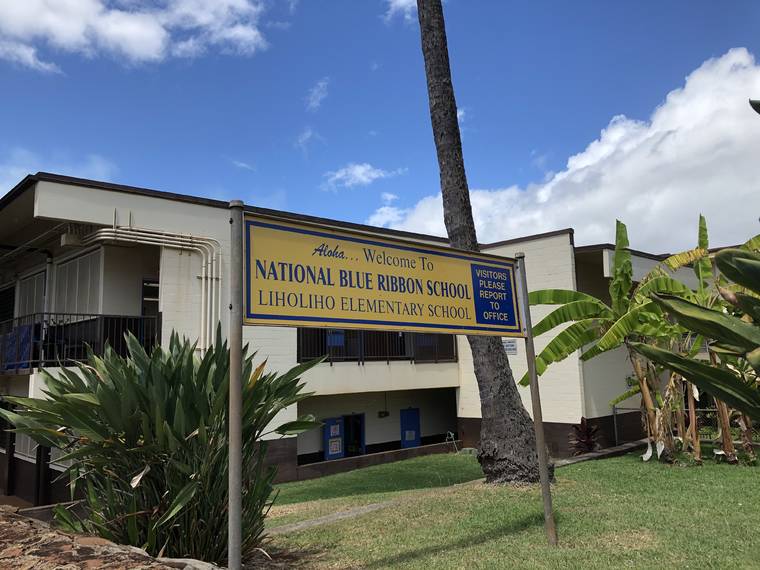Liholiho, E.B. de Silva and Waikiki Elementary honored as National Blue Ribbon Schools

CURTIS MURAYAMA / CMURAYAMA@STARADVERTISER.COM
Liholiho Elementary in Kaimuki was recognized as a 2020 National Blue Ribbon School today along with Waikiki School and E.B. de Silva Elementary in Hilo.
Three Hawaii elementary schools were named 2020 National Blue Ribbon Schools today and all are repeat winners — Waikiki School, Liholiho School in Kaimuki and E.B. de Silva Elementary in Hilo.
Each was recognized as an “exemplary high-performing school” by U.S. Education Secretary Betsy DeVos, based on their academic prowess. But leaders at all three public schools say their academic success stems in part from a focus on fostering their students’ social and emotional well being.
Liholiho was recognized as a Blue Ribbon School in 2004 and 2011; Waikiki School in 2007 and 2013; and E.B. de Silva in 2014. They were among 367 public and private schools to receive the coveted National Blue Ribbon award this year.
News of the awards came as a welcome lift to staff at the schools as they deal with the coronavirus pandemic and the challenges of providing distance learning for most students.
Principal Christina Small, who has been at Liholiho Elementary for 26 years, says the school strives to create a culture of empathy and collaboration. It also enhances students’ critical thinking and ability to find multiple solutions to challenging problems.
“Foremost in everything, above all, the curriculum focuses on the thinking process,” Small said in an interview. “We are so lucky that each generation of teachers is trained by the former generation, they mentor them.”
Don't miss out on what's happening!
Stay in touch with breaking news, as it happens, conveniently in your email inbox. It's FREE!
“Especially during this pandemic, they’ve been working so hard learning new ways of teaching online and meeting the social-emotional needs of students at this time when there is a lot of stress on families.”
The school’s math and English proficiency rates were more than 17 percentage points above state averages. About a quarter of Liholiho’s students are English language learners and more than 30% are economically disadvantaged, Small said.
“You have to have a loving, caring environment before you raise achievement,” Small said. “I’m fortunate to have great teachers and great staff on this 26-year journey. It’s like my second family.”
Waikiki Elementary, known as “the mindful school,” has long relied on the Habits of Mind model to “prepare students to do as well on the tests of life as they do on the tests they take at school,” said Principal Bonnie Tabor. Another pillar of the school is the Philosophy for Children (p4c) model.
“Our goal is to create thinkers and thoughtful human beings who are committed to using all their talents to make the world a better place,” said Tabor, who is in her 18th year as principal and started there as a counselor.
“The strength of the school lies in the strength of the teaching staff, and the teachers are super strong professionals and people,” she said. “The culture of our school is what we think is key to our success. We are all continuing to grow. We are all lifelong learners.”
The school has strong partnerships with nearby entities, such as the Honolulu Zoo and the Waikiki Aquarium. Students made videos to go along with the exhibits in the aquarium and act as docents there.
A mosaic art project created by Waikiki School children offers a “Wheel of Misfortune” at the zoo that visitors can spin to learn about various endangered species. Visitors are also directed to a website to find out what they can do to help. Such projects grew out of students’ interests.
The school also has a farm that has grown produce for the community and tended indigenous seedlings to be planted on the park grounds of Diamond Head State Monument.
Waikiki School and Ernest Bowen de Silva Elementary each exceeded statewide proficiency rates in English and math by 21 percentage points.
De Silva Elementary mixes students across grade levels into five “hale,” or houses, to foster a greater sense of belonging to the school, as well as the broader community.
“Hale is the Hawaiian word for home,” Principal Dennis O’Brien wrote in the application. “The school is a home away from home for the students and faculty alike.”
“The goal of each Hale is to bring the campus together and vertically integrate our student body and faculty for events which include canned food collections, attendance and reading competitions, and women’s shelter hygiene drives.”
The system builds community and honors students’ voices, he said. The school recently revamped its approach to math and science, and has seen promising results.
“We wanted to incorporate the child’s innate sense of wonder, the how to do it, and the ability to find a solution,” O’Brien wrote.
This year’s National Blue Ribbon Schools awards ceremony will be held virtually on Nov. 12 and 13.



